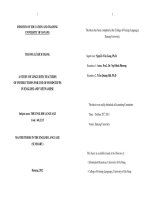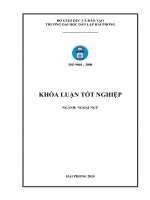Study, Design and Manufacture Microstrip Antenna For Advance Mobile Handsets
Bạn đang xem bản rút gọn của tài liệu. Xem và tải ngay bản đầy đủ của tài liệu tại đây (1.32 MB, 5 trang )
<span class='text_page_counter'>(1)</span><div class='page_container' data-page=1>
59
Study, Design and Manufacture Microstrip Antenna For
Advance Mobile Handsets
Tran Minh Tuan*
<i>National Institute of Information and Communications Strategy, 115 Tran Duy Hung, Hanoi, Vietnam </i>
Received 19 March 2010
<b>Abstract. This paper concentrates on studying, designing and manufacturing a dual – band and </b>
high – bandwidth antenna applied for advance mobile handsets. This antenna can work in
GSM/UMTS bands by generating two resonant modes of 900 MHz and 1900 MHz frequencies.
Antenna is printed on FR4 substrate with size of 58 mm x 80 mm, thickness of 1.6 mm and
<b>relative permittivity of 4.4. The propose antenna is experimentally studied. </b>
<i>Keywords: Antenna, dual-band, monopole, microstrip antenna. </i>
<b>1. Introduction</b>∗∗∗∗
Nowadays, 3G mobile terminals are gaining
immense popularity thank to their advanced and
user-friendly features. Therefore, designing new
compact antennas with good characteristics,
easy to manufacture and low cost applied for
advance mobile terminals is quite necessary
although number of similar studies had been
conducted so far [1-4].
In this paper, this antenna is chosen because
it has advantages by its characteristics such as
easier to design and manufacture than the PIFA
antennas.
Thank to simple structure and
omni-directional radiation, monopole antennas have
been found widespread applications in mobile
communication systems. To meet the
miniaturization of modern mobile
_______
∗<sub>Tel.: 84-4-35565043. </sub>
E-mail:
</div>
<span class='text_page_counter'>(2)</span><div class='page_container' data-page=2>
Fig. 1. Overview the antenna.
<b>2. Designing antenna and simulation results </b>
Fig. 1 shows an overview of the antenna.
Antenna is printed on an FR4 substrate which
size is 58 mm x 80 mm with thickness of 1.6
mm and relative permittivity of 4.4.
The antenna consists of a 1/4 wavelength
vertical element over a solid sheet or radial wire
ground plane with diameter of 1/4 wavelength.
monopole at the right-hand side. These
extended conductor lines are located relatively
close to the rectangular meander monopole. The
space between the two conductors is 0.5 mm. In
this design, the extended conductor line
increases the current path of the antenna’s first
resonant mode, which reduces the required size
of the proposed antenna for a fixed operating
frequency.
Moreover, as the conductors are close to
each other, the electromagnetic 2 coupling is
created between the conductors, which leads to
the second resonant mode excited with good
impedance matching. That is, by introducing
the extended conductor line, the proposed
compact dual-frequency monopole antenna with
good impedance matching can be obtained [5].
In addition, there are 2 ground planes are
put on the only layer with the antenna, each
one’s size is 25mm x 30 mm. By placing 2
ground planes and radiator of the antenna in a
layer together, ground plane acts like a mirror,
to reflect a ghost image of it. That way it will
act like a half wavelength antenna, but only be a
quarter wavelengths long [6]. And there are 2
pieces of copper are using to connect the layer
that containing the antenna with a part of other
layer of the FR4 substrate which its size is
58mm x 3 mm. It makes the antenna likely to
be fed by a CPW connector although a 50 Ohm
SMA connector is used to feed the antenna.
</div>
<span class='text_page_counter'>(3)</span><div class='page_container' data-page=3>
Fig. 2. S11 parameter (dB).
As shown in fig. 2, two resonant modes are
excited at 910 and 1900 MHz simultaneously
with good impedance matching. The 10-dB
return-loss bandwidth at the lower frequency is
52 MHz (882 - 934 MHz). And the bandwidth
at the upper frequency reaches to 521 MHz
(1724 - 2245 MHz). Obviously, the obtained
bandwidths cover both the GSM/UMTS bands.
<b>(a) XOY plane </b>
(b) XOZ plane
<b>(c) YOZ plane </b>
Fig. 3. 2D Radiation patterns.
(a) 900 MHz
</div>
<span class='text_page_counter'>(4)</span><div class='page_container' data-page=4>
Fig. 5. The measurement result.
Fig. 6. Comparison between the simulation and
measurement.
Prototypes of the proposed antenna were
constructed and tested). Good agreement
between the measurement and simulation is
obtained. Two resonant modes at about 900 and
1900 MHz are successfully excited. The lower
resonant mode shown an impedance bandwidth
of 45 MHz (877 ~ 922), which covers most of
required bandwidth of the GSM system. For the
upper resonant mode, it has an impedance
bandwidth of 362 MHz (1760 ~ 2122) which
also cover all required bandwidth of the DCS
system.
Fig. 7. The real antenna.
<b>4. Conclusion </b>
The designed antenna suitable for
GSM/UMTS operation in an advance mobile
handsets has been demonstrated. The return loss
bandwidths of the lower and upper modes of
the proposed antenna cover the required
bandwidths of the GSM/UMTS systems. The
proposed antenna is especially suited for
application in 3G mobile handsets.
<b> Acknowledgements </b>
This work is supported in part by Korea
advanced institute of science and technology –
Information Communications College (KAIST
ICC) of Korea.
<b>References </b>
[1] Peter Lindberg and Erik Ojefors, “A bandwidth
enhancement technique for mobile handset
<i>antennas using wavetraps”, 2006 IEEE, vol.54, </i>
pp.2226-2233, August 2006.
</div>
<span class='text_page_counter'>(5)</span><div class='page_container' data-page=5>
[3] Kin-Lu Wong, Yuan-Chih Lin, and Ting-Chih
Tseng, “Thin internal GSM/DCS patch antenna
<i>for a portable mobile terminal”, 2006 IEEE, </i>
vol.54, pp.238-242, January 2006.
[4] P.Nepa, G.Manara, A.A.Serra, and G.Nenna,
“Multiband PIFA for WLAN mobile terminal”,
<i>2005 IEEE, vol.4, pp.349-350, 2005. </i>
[5] Phan Anh, “Antenna Theory and Technique”,
Science and Technical Press, Hanoi 2000.
[6] David M. Pozar, Microwave Engineering, John
Wiley & Sons, INC, Second Edition.
Nghiên cứu, thiết kế và chế tạo anten mạch dải đa băng cho
các đầu cuối di động thế hệ mới
Trần Minh Tuấn
<i>Viện Chiến lược Thông tin và Truyền thông, Bộ Thông tin và Truyền thông, </i>
<i>115 Trần Duy Hưng, Hà Nội, Việt Nam</i>
</div>
<!--links-->









